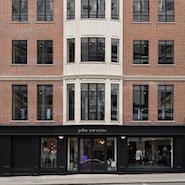- About
- Subscribe Now
- New York,
September 2, 2015

 Exterior of John Varvatos London boutique
Exterior of John Varvatos London boutique
The United Kingdom’s luxury market is worth $49.5 billion, with that number forecast to increase to $78 billion to $87 billion by 2019, according to a new report from Walpole.
Other notable numbers highlighted in the report include an increase from approximately 113,000 employees to between 160,000-180,000 by 2019, the contribution of $8 billion in taxes and the exportation of luxury goods valued at $38.3 billion. The optimistic predictions will be impacted heavily by factors such as tourism and should keep brands creative and forward-thinking when it comes to tapping into new markets and staving off competition.
“British fashion, luxury products, cultural industries and design are amongst the U.K.’s most prolific exporters, prized around the world for their quality and distinctiveness," said Edward Craig, head of the retail and leisure group at Charles Russell Speechlys, London. "But businesses in the sector risk losing ground in a competitive global marketplace: threats range from Chinese counterfeiters to an inability to secure visas for skilled workers to work in the U.K. Most of these issues will have a legal dimension."
Walpole commissioned the report from Frontier Economics.
Strength in numbers
National data often excludes particular products, such as high-end automobiles, or does not separate luxury items from mass-market items when examining the growth and contributions of particular sectors, so Walpole’s data aims to give a more complete picture of luxury’s importance to the British economy. Accordingly, numbers listed above include luxury’s indirect contributions to the economy, caused, for example, by a luxury hotel increasing traffic and revenue in surrounding small businesses.
Bukhara London Hotel
The report includes a sector-by-sector breakdown, which shows that automobiles account for $28 billion, more than half the $49.3 billion provided by luxury as a whole. The next closest sectors, apparel and accessories and hotels, account for slightly less than $10 billion combined.
The large numbers lead, indirectly, to a great impact on U.K. citizens. Three percent of jobs created in the country from 2010 to 2013 are in the high-end cultural and creative industries, equating to employment growth of 12.6 percent in the same period, plus another 10,000 to 12,500 generated indirectly, assuming the same ratio of direct to indirect employment growth in the United Kingdom as in the rest of the European Union.
Chinese tourists outside a Louis Vuitton store
Among the larger extrapolations from the data is an expected increase in tourism, which could brush into trouble with London’s airports quickly approaching capacity and a current lack of daily flights to high-growth markets region wide. Growth in economy is frequently spearheaded by luxurious spenders, who double as potential overseas consumers, so a lack of easy transportation could negatively impact the U.K.’s growth in luxury and tourism.
The heavy indirect impact the luxury industry has on a country may motivate brands to give back, while a potential increase in tourism is a reminder that luxury brands are becoming increasingly global and will need to make headway in order to hit the more optimistic end of Walpole's projections. In particular, the U.K. will need to tap into emerging markets like Brazil, India and Russia in addition to China, as well as build connections with oil exporters in the Middle East in order to continue growing at such high rates.
Tourists in a rickshaw in Beijing
Nevertheless, potential threats also loom, ranging from recent drops in the stock market that could rattle consumer confidence to Amazon’s penetration of luxury households, intellectual property laws and the ease of counterfeiting merchandise that will emerge as 3D printing becomes more accessible.
Trickle down
Walpole reports a growth of almost 10 percent for U.K. luxury from 2012 to 2013, with increases expected year-over-year for the remainder of the decade, but despite the strong numbers from the country, other reports have found less encouraging numbers for global luxury.
The Boston Consulting Group recently announced its prediction that luxury sales growth will slow to single digits over the next 10 years.
Strong sales figures from China have played a huge part in the industry’s near double-digit growth year-over-year for the past decade. With Asian luxury consumers reeling in their spending and luxury consumers holding steady throughout the rest of the world, BCG posits a modest 4 percent growth figure well into the year 2020 (see story).
Brands should be weary of expecting potential consumers in emerging markets to flock to them. Shopping tourism is growing, but to best reach these potential consumers, fashion brands and retailers should begin marketing to them before they leave their home country, according to a May 2015 report from Fashionbi.
Just as travelers heavily research hotels, restaurants, sites and entertainment before embarking on a trip, they are also using online media to plan their shopping excursions. Brands should ensure they are catering to their potential international clientele with Web sites in their native languages and social accounts on the platforms popular in different markets (see story).
“For the growth forecasted in this report to materialize, companies must assertively protect their intellectual property, commercial and digital rights around the world, and they must continue to access and export to global markets," Mr. Craig said. "Visas and digital governance issues will become more important.
"Our luxury sector is the jewel in the crown of U.K. industry, and it is important that the right policies and legislation are in place to foster their continued growth.”
Final Take
Forrest Cardamenis, editorial assistant on Luxury Daily, New York
Share your thoughts. Click here